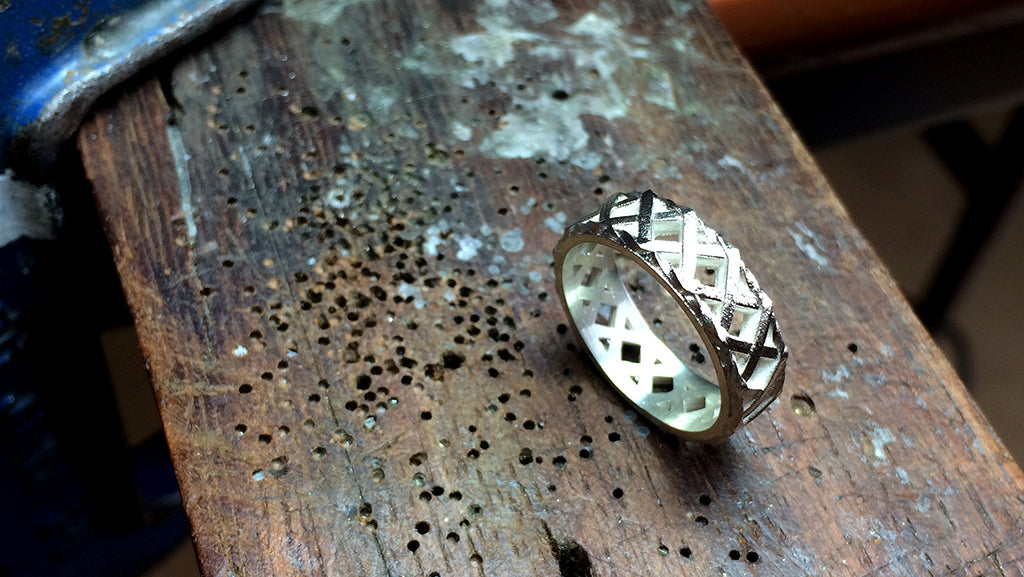Your Cart is Empty

Over gold, platinum has earned its rank for a number of reasons. For starters, gold is far more abundant in the earth’s crust, making platinum rarer. Whilst 1,500 tons of gold are mined annually, only 160 tons of platinum are extracted. When people ask 'Why is platinum not as popular as gold?,' it's less a question of popularity and more a matter of rarity.
Platinum is also denser than gold, thus heavier. Because precious metals are priced by weight, platinum has long been the high-cost option in the context of buying jewellery. But why pay the price for a platinum ring when you could opt for exactly the same setting in white gold for half the cost?
Well, that’s because platinum is also more durable than gold. Its density contributes to its respectable ranking of 4 - 4.5 on the Mohs Scale of Hardness, trumping gold and its hardness of around 2.5 - 3. This toughness makes platinum the perfect choice for day-to-day attire, as it requires less maintenance than other metals and can withstand the most wear and tear.
If it’s a toss-up between platinum and white gold, who share a similar aesthetic, then platinum wins on the hypoallergenic front, too. In order to achieve white gold’s silvery hue, yellow gold must be alloyed with white metal(s) such as silver, nickel, manganese and/or palladium. Nickel in particular is an allergen for many people, earning white gold its itchy reputation. Whilst there’s no such thing as ‘pure white gold’, platinum is naturally grey-white in colour and can only be sold as platinum if 90-95% pure. This not only makes it hypoallergenic, but also means a no-fade guarantee is intrinsic in every piece of platinum jewellery.
 The platinum foundations of Anna's bespoke engagement ring, which eventually came to hold a nimbus of square-cut orange sapphires
The platinum foundations of Anna's bespoke engagement ring, which eventually came to hold a nimbus of square-cut orange sapphiresGiven its superiority, the average cost of platinum has always been higher than that of gold. It makes sense; it’s rarer, weightier, hardier, and thus more desirable.
But, in recent years, platinum’s been overtaken by gold in the pricing ranks. Now averaging at around 2.4 times more expensive than platinum, gold is the most priciest it's ever been.

It's no secret that gold prices are at an all-time high, for reasons far too multifaceted and complex to explain here.
In the context of white gold specifically, palladium is partially to blame. White gold is created by alloying roughly 75% yellow gold and 25% other elements – a large proportion of which is palladium. Now suddenly the most valuable of the four major precious metals, palladium is the lustrous chemical element responsible for white gold’s silvery hue. It is a by-product of platinum and nickel mining and so its output is often slow. Over the last few years, its supply hasn’t responded to growing demand, causing a surge in price. Use of palladium is increasing as governments, especially China’s, tighten regulations to crack down on vehicle pollution, forcing car manufacturers to increase the amount of precious metal they use.
The knock-on effect is a spike in the cost of white gold, too; so much so that it’s overtaken platinum for the first time.

Platinum prices could remain low, or this moment in time could be anomalous. Either way, the sturdy and attractive white metal is currently more affordable than it’s ever been.
Honesty and transparency are at the very core of Lebrusan Studio’s ethos. That’s why we’re sharing these insights with you today and why we’ve just re-addressed the prices of all of our jewellery, adjusting in accordance with the ever-shifting precious metal climate. For the first time ever, our platinum pieces are no longer more expensive than our white gold jewels.
 Jorge's bespoke Art Deco-inspired engagement ring, cast in recycled platinum
Jorge's bespoke Art Deco-inspired engagement ring, cast in recycled platinum
In many instances, life’s about grabbing the bull by the horns. But, if you’re like us and don’t support exploitation of any sort, then the ‘Get buying!’ narrative might not sit comfortably with you; particularly in regards to a metal like platinum that’s short in natural supply and whose mining process places considerable pressure on the environment. If that’s the case, then look no further. For jewellery that’s fairly priced AND assures no further displacement of fragile ecosystems, Lebrusan Studio is your place.
All of our platinum jewels are cast in recycled platinum from a fully certified and single-recycled source. This means that when you buy a beautiful and long-lasting platinum piece from Lebrusan Studio, you’re not contributing to the use and abuse of our natural resources inherent in mining new metal from the ground.
And if you’re keen to know more about where the recycled metal in your jewellery comes from? Feel free to drop us an email; we’re always happy to help.
Check out our collections of platinum engagement rings and wedding bands or get in touch today to discuss an utterly unique bespoke platinum creation.
 Our Scrolls Engraved platinum wedding band
Our Scrolls Engraved platinum wedding band
